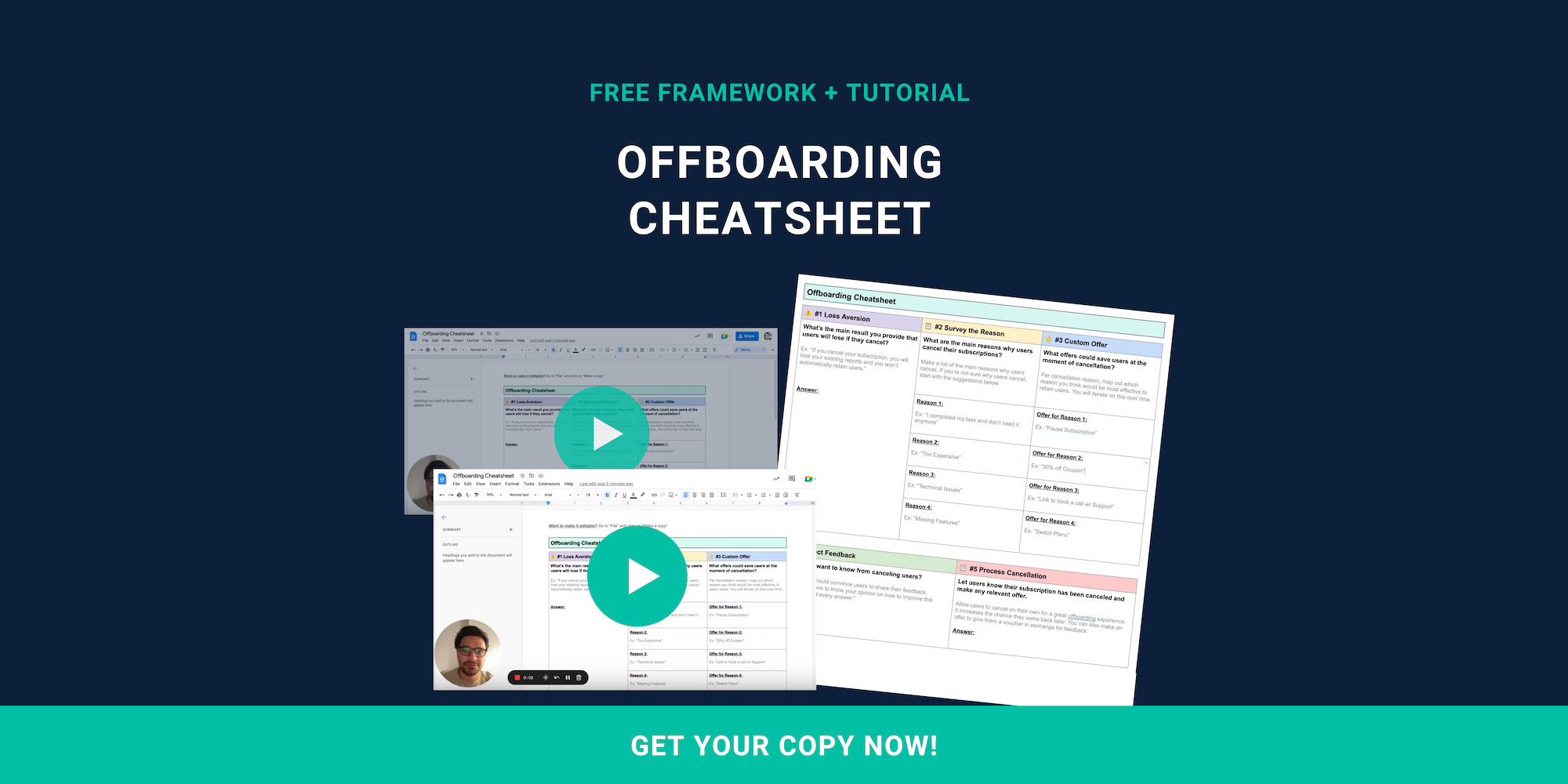Earlier this year I decided to buy a self-help journal. You know, that book that’s supposed to help you keep New Year’s Resolutions, get in shape, dominate the world and take over a country? That thing.
I liked my journal, with its inspiring quotes from famous people, tear out pages, and hipster fabric cover. I even used my journal for a month or two. Now, it’s March, and my goal is to start writing goals again.
Before I broke bad, I read the journal’s introductory pages, probably not much different from your company’s onboarding blog. Mostly it was ra-ra self-help pep talk (aka “bad content”).
One argument did make it into my brain, however, and it was this: start your day with the task you hate the most. Mornings are generally when we are most productive, the argument goes, and conquering the hardest task first sets the tone for the day.
In our experience, recurring revenue companies are failing the first lesson of self-help-journal 101. They aren’t tackling the hardest job first. Sure, they are spending lots of time and money to perfect onboarding, but they’re ignoring their cancellation process. Either they don’t have one, or the one that they have is miserable.
Studies have shown that reducing churn by five percent can increase profits anywhere from 25 percent to 95 percent. So why don’t more recurring revenue companies take churn seriously? Because it’s the hardest job, and the easiest to put off until last. Here are some of the ways companies deal with churn, how they fail, and why, in our experience, the best approach is a normalized, cancellation workflow:
The “Cable Company” Model: Cancellation is Not an Option
In our experience, some Saas founders require customers call or email to cancel. Why? Because founders fear that easy cancellation leads to more cancellations, and they often delay or avoid building a cancellation flow until it is too late.
The unintended consequences of this approach are severe. Customers reserve a special level of contempt for companies that require they contact a live body to cancel. Don’t be the cable company. Contact-driven cancellation is a churn prevention scheme, not a churn reduction plan, and it damages your company’s reputation.
Cancellation is not something to be feared. It is a normal part of the recurring revenue business cycle that should be automated, understood, and leveraged.
The Hands On Founder: “Who likes taking sales calls?”
When it comes to cancelling customers, some founders think they’re Oprah:

At least the sentiment is right. Customers are allowed to cancel, and companies have the opportunity to gather information from the customer before they leave.
However, unless you are selling massive, long-term contracts, personal contact from the founding team can scare away new customers because it puts too much pressure on them to be unique. A customer wants you to solve the problem you are promising to solve. If your customer wanted to be part of a founding team, they would’ve started their own company! There has always been safety in numbers. The ability to anonymously come and go from a product and talk to a live person when desired adds legitimacy and respectability to a small or new venture.
In “Content Machine,” Dan Norris suggests that you shouldn’t waste time writing good content to support a bad business concept. One sign of a bad business concept, according to Norris, is when the company cannot afford to replace its founder with someone in a full-time position. The founding team is not a call center. If the founders have to call each and every cancelling customer, maybe the business isn’t viable in the first place.
Requiring the founder to serve as the cancellation clearing house creates more problems than it solves. Who will call? When? What will be offered to persuade a customer to stay? What questions will be asked? How will we log the information learned? How will be able to examine the aggregate date derived from conversations with cancelling customers? All of these are critical parts of the cancellation process that no founder can normalize. Let founders found. Keep them out of the cancellation process for the reputation of the company, and for the normalization of the cancellation process.
The Call Center Approach: Partially Passive, Still Inconsistent
You’ve seen it by now, the chat box. It links you to a face, someone at the company who can answer questions. The chat box is an onboarding darling. It makes it seem like you are just a click away from a live person, and sometimes you are.
Like the founder-fixes-all dilemma, the virtual call center is a well-intentioned but ineffective solution to cancellation. Who is in charge of the call center? Who will users talk to when they click the chat box to cancel? Are cancelling customers all asked the same questions? Are they presented with the same options?
The real people who work for your company need to spend time on real problems. Cancellation is a real problem, but only in the aggregate. You don’t reduce churn by saving one cancelling customer. We reduce churn by learning the aggregate lessons that our cancelling customers are teaching us as a group.
If your company is using the chat box approach, it’s just an automated process pasted onto a human one. You are still relying on people to normalize your cancellation flow. Your human resources are not your churn process, but your churn think tank. Empower your team to leverage churn data to make the serious decisions about your company and its future.
The Smart Cancellation Flow: A Passive, Dynamic Churn Reduction Think Tank
In our experience, a smart cancellation workflow solves most if not all of the problems identified above. It avoids the “Cable Company” dilemma by offering a simple, respectable cancellation process. A smart cancellation flow relieves the founder from call center duties and protects the company’s brand. Avoiding the chat box and opting for a passive workflow further streamlines the process by guaranteeing that all customers have the same experience when they want to cancel. This includes asking the same questions and offering the same solutions. There’s no way to quality control test the questions or solutions offered unless they are offered to all.
Finally, cancellation flow is the only realistic way for a recurring revenue company to understand the big picture that churn presents when viewed at large.
Let’s take the self-help journal as an example, and suppose it was a digital journal purchased on a monthly subscription. Suppose I used the journal for a few months and stopped. The onboarding team might see that a few months in, I stopped using, and send me a reminder. Let’s say none of those reminders worked, and that eventually, I emailed in and decided to cancel. With the Cable Company model, I would grow to despise the company for ignoring me, and cross it off my list for future purchases or referrals, all because the company wanted to squeeze a few more months out of me before I finally lost my mind and sent a nasty email or made a nasty phone call.
Getting a call from a founder would have been off-putting, to say the least, given how little I probably paid for a recurring consumer product. Odds are extremely high that I would never even return that phone call, making it a waste of the founder’s time and failing to offer any useful information on why I decided to cancel.
The chat box option would make it easy for me to cancel, but the odds of my experience being aggregated with others, for the company’s benefit, would be very low. Maybe on the day I chatted in, “Bob” answered my text and asked me different questions and offered different incentives than “Joe” the day before.
If the journal company had a cancellation flow, I could easily decide to cancel, explain why I decided to cancel, and potentially be reminded how I used the journal to make actual changes to my routine. Reminded of the value of the journal, maybe I would have stayed. But even if I didn’t, at least the company could have decided whether my reason for leaving meant anything to them.
Saas and other monthly revenue companies mine their onboarding process for clues about how to make changes or adjustments to their company to attract more customers. CITE statistic.
Most of these companies are not taking similar cues from their cancelling customers, but they should. After all, whose perspective is more valuable to a recurring company: the new user or the one who has already tried the product for a period of time and decides to leave? This is someone who has engaged in all aspects of your business. Marketing, onboarding, actual use of the product, and making the decision to go elsewhere. Why isn’t this person more important than the new user?
The only way to reduce churn is to learn from it, and the only way to learn from churn is to aggregate it. A smart cancellation flow makes this a reality.
To discover how Raaft can lower your Churn for your Saas, book a demo from Raaft today!

Offboarding Cheatsheet
This framework + video tutorial will help you design a better cancellation process.
Some of our featured articles

Adam Crookes

Miguel Marques

Adam Crookes
Customer Success insights in your inbox
Helping Founders and Customer Success Managers handle customer retention effectively.
We will only ever send you relevant content. Unsubscribe anytime.


